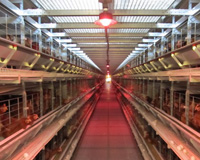Canadian poultry farmer pleased with LED lighting

Quebec poultry producer Maurice Richard recently changed his barn to be illuminated entirely with AgriShift PLE Dim-to-Red LED Poultry Lights for layers claiming.
“This is the best flock we’ve ever had at the start,” exclaimed Richard in reference to the performance of 22,000 laying hens in the barn.
No stranger to poultry farming, Richard was new to the idea of LEDs being used to reduce electrical lighting costs while increasing the productivity of his egg laying operation. He now considers himself to be on the leading edge of what he believes will quickly become the standard light source for the industry.
“We’ll continue to accumulate data and see how it goes from here,” said Richard, “but at this point we’re very pleased. Our hens are 22 weeks old and we’re already at 95% productivity. This is well beyond our expectations from a productivity standpoint and the birds look extremely healthy, too.”
Quebec Minister of Agriculture, Fisheries and Food, Pierre Corbeil addressed members of the media and poultry industry and toured the Richard farm during a recent grand opening celebration.
Richard installed 130 AgriShift® PLE Dim-to-Red Poultry Lamps that provide his layers with more light in the red wavelengths while still providing enough blue; a light spectrum that has been shown to enhance egg production and reduce stress in domestic fowl. According to Dennis Bonet, Director of International Sales for Once Innovations (ONCE), the developer and manufacturer of AgriShift® LED Poultry Lamps, “Maurice is able to simulate day and night photoperiods and the light spectrum of sunrise and sunset with dimming controls. This provides the birds with the most natural light environment possible and stimulates healthy biological functions such as melatonin production that reduces stress and increases egg production.”
The AgriShift PLE Dim-to-Red LED Poultry Lamp for Layers saves approximately 88% of the cost of electricity for lighting compared to traditional incandescent lamps and is rated to last seven to ten years under normal barn conditions.
Source: Once Innovations (ONCE)













